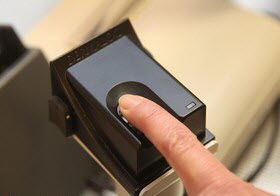Answers to Your Biometric Access Control Questions

Image Courtesy of Rex Features
When security is your primary concern, biometric access control might be the ideal solution. Biometric access is a form of security used by banks, government organizations, and other high-security industries and is considered one of the most reliable types of access control available.
Defining biometric access control
Simply put, biometric identification refers to the use of fingerprints, facial recognition, retinal scanning, iris scanning, or most other biological identification methods as security measures. Rather than using an access code or key card, each person granted access to a specific area must present a part of his or her body for scanning prior to gaining entry.
For example, there might be a room in an office where sensitive information is stored. By deploying a biometric access control solution, one might enjoy greater security while not hampering those who need access to the information stored there. It is much easier to steal a key card or guess a PIN number than to manipulate a retinal or fingerprint scan.
As technology has become more accessible, hacking personal identification numbers (PINs) and access codes is even easier for those wishing to gain unauthorized access to information and facilities. PINs and passwords are used on almost every personal account, such as an ATM or for a computer login. Users are encouraged never to write down a password or reuse it for multiple security purposes, but more often than not, a password is passed along from person to person, making a security breach inevitable.
Because of the risks associated with PINs, many businesses rely on biometric authentication to differentiate individual physical characteristics that can't be replicated from one person to another. While a password can be corrupted or copied, biometric access is user-friendly yet stringent in its security protection.
How biometric access control works
There are several different ways biometric access control systems can be used for security purposes. In its most basic form, a software program can store biological data, which is then compared to the scan employed when an individual presents that same data for access. This data could be anything from a retinal scan to a fingerprint. Of course, more sophisticated technology is also available. For example, the U.S. government can use holographic images for facial recognition when government employees need to gain access to secure areas. Since different employees have varying access levels, biometrics is the easiest way to ensure that only approved workers enter restricted areas.
The features to look for
When you decide to use a biometric security solution for your business, it is important to consider features that will be available to you and price. Ideally, the biometric security system you choose should fit within your budget and provide sufficient security to ensure limited access areas cannot be accessed by unauthorized individuals.
Size is an important consideration when reviewing biometric access control products. Some biometric security equipment is no larger than a doorknob and can be used on any access point. Other pieces of equipment are much larger and require a security attendant to assist with operation.
One of the most common forms of biometric security devices in use today is the biometric door lock. This device uses fingerprint scanning to permit or deny access to restricted areas. When using this type of system, industry experts recommend purchasing a product that is reversible so it can be fitted to any door. You may also prefer additional features, such as a system that allows executives to manually override the biometric identification in case of emergency. A system with a high reliability rating is recommended, but will still not preclude the need for some sort of manual bypass.
Cost
When purchasing a biometric system, make sure to obtain several price quotes to compare prices and product lines. A single fingerprint reader can cost as little as $50 if one chooses to install it themselves. While most shops and offices need never use more than fingerprint readers, other options are available.
Full service installation of a single biometric hand reader with locking system for the average office or shop (1-25 employees and 2 doors) can cost upwards of $5,000 when installed by a professional. Research and consultation will clue you in on your security needs and help better define your budget.
Start your search today with BuyerZone's free request for access control price quotes - we'll match you to multiple qualified dealers in your area who can provide the best biometric security system for your requirements.
Ready to Compare Access Control Systems Price Quotes?